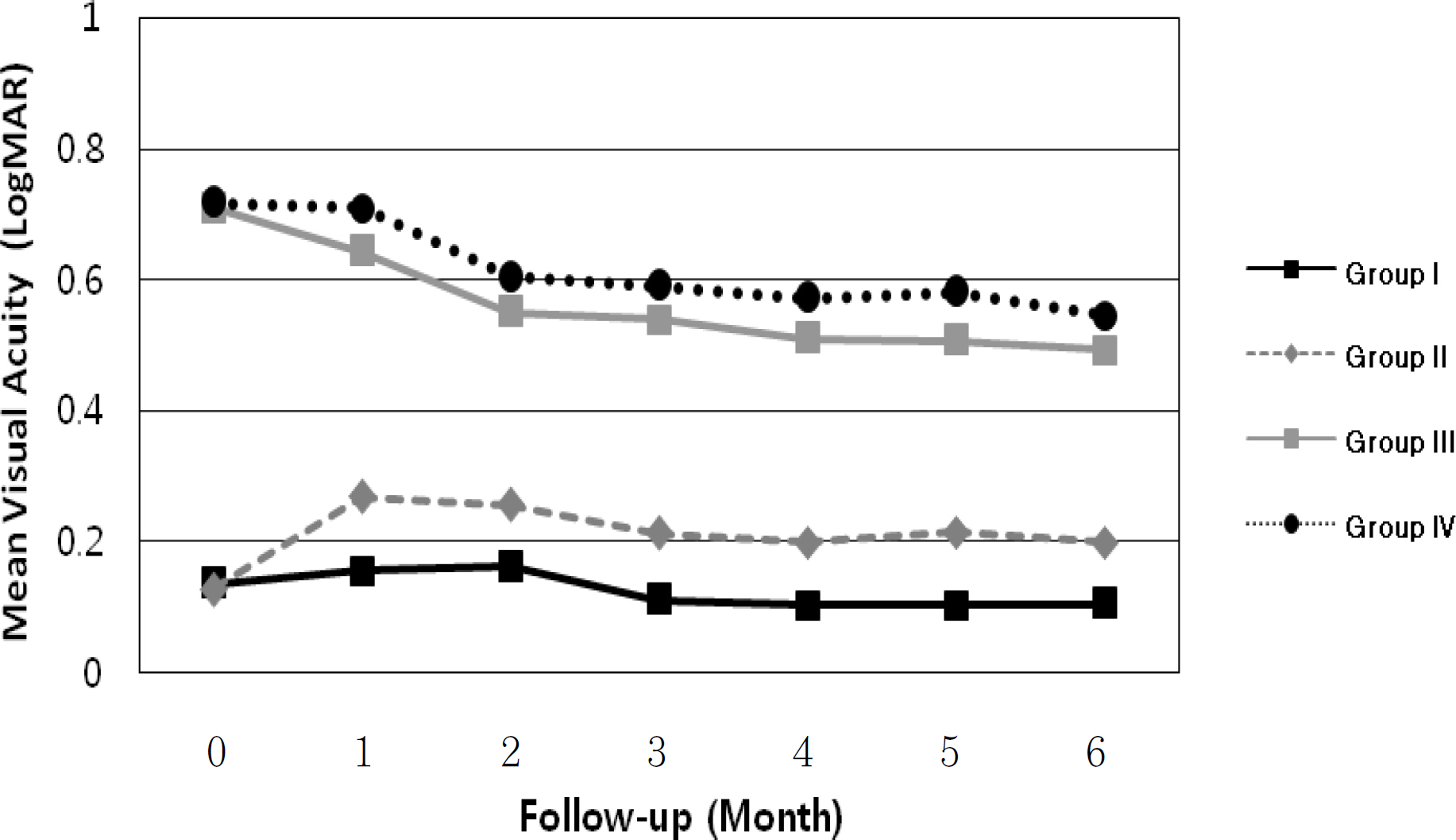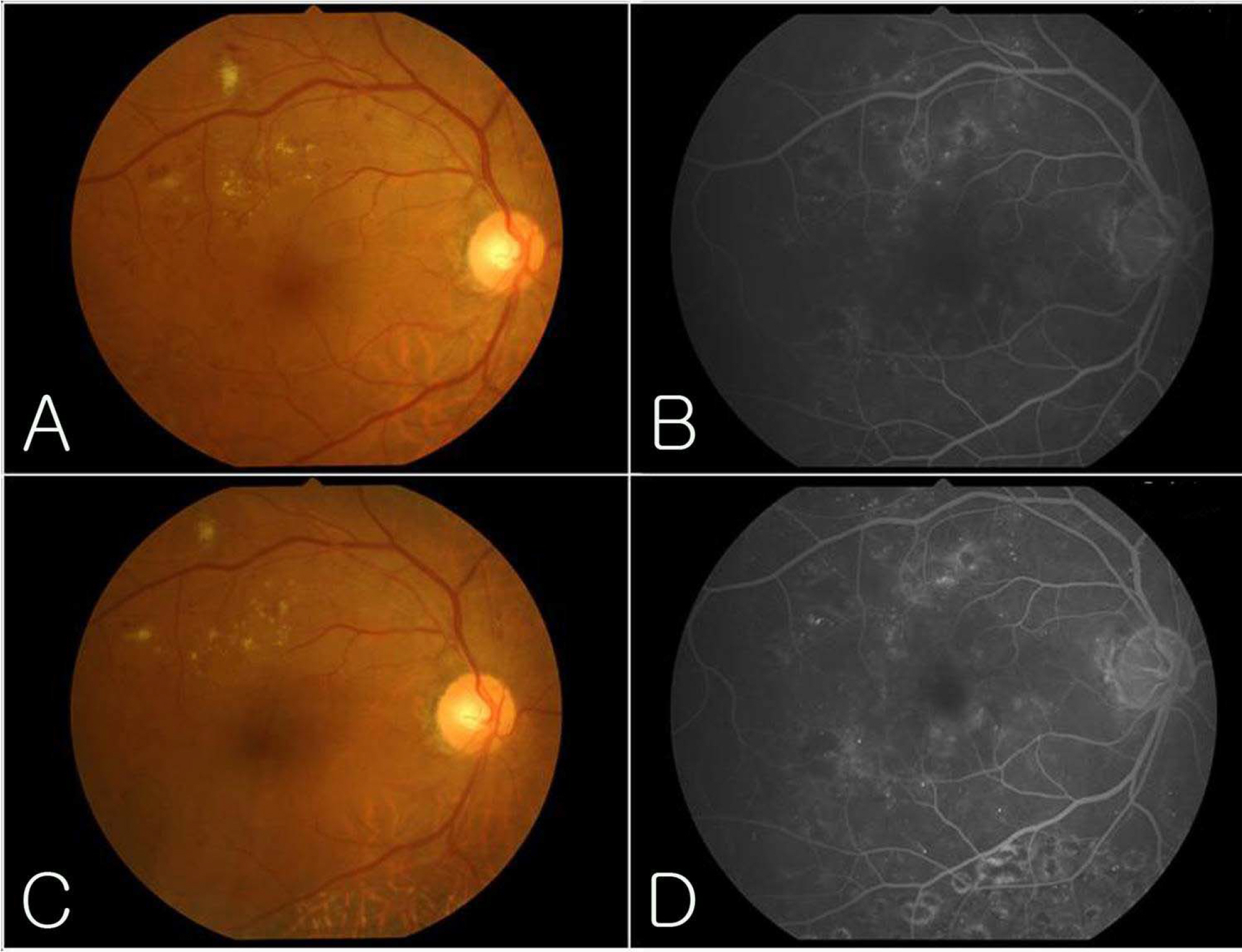J Korean Ophthalmol Soc.
2008 Jan;49(1):71-80. 10.3341/jkos.2008.49.1.71.
The Combined Effect of Subtenon Triamcinolone Injection and Panretinal Photocoagulation on Diabetic Retinopathy
- Affiliations
-
- 1Department of Ophthalmology and Visual Science, College of Medicine, The Catholic University of Korea, Seoul, Korea. parkyh@catholic.ac.kr
- KMID: 2211185
- DOI: http://doi.org/10.3341/jkos.2008.49.1.71
Abstract
-
PURPOSE: To investigate the result of posterior sub-tenon triamcinolone acetonide injection combined with panretinal photocoagulation (PRP) in patients with diabetic retinopathy.
METHODS
A prospective study was performed on patients with diabetic retinopathy who required PRP. The study group consisted of 12 patients (12 eyes) of diabetic retinopathy without clinically significant macular edema (CSME) and 13 patients (13 eyes) with CSME. All patients were injected posteriorly with sub-tenon triamcinolone acetonide (40 mg) one week before PRP. During a six-month follow-up, best-corrected visual acuity, the development of macular edema, changes in fluorescein angiography, and related complications were monitored.
RESULTS
During a six-month follow-up, visual acuity was well preserved in patients with diabetic retinopathy without CSME (12 eyes). Only one patient in this group experienced temporary macular edema at 3 months after combined therapy. In the CSME group (13 eyes), the visual acuities of seven patients (53.8%) increased, those of five patients (38.5%) remained same, and one patient's visual acuity (7.7%) decreased in a study period of six months. Fluorescein angiography showed that macular edema was resolved in most patients except in one patient in whom macular edema remained for up to 6 months. Complications from combined therapy occurred in two patients who showed slight and temporary increase of intraocular pressure.
CONCLUSIONS
Combined treatment with posterior sub-tenon triamcinolone acetonide injection and PRP may provide benefits for patients with diabetic retinopathy who require urgent PRP by preventing exacerbation of macular edema.
MeSH Terms
Figure
Cited by 2 articles
-
Short-term Effect of Intravitreal Bevacizumab Injection Preventing Panretinal Photocoagulation-Induced Macular Edema in Proliferative Diabetic Retinopathy
Jung Sub Kim, Ho Ra
J Korean Ophthalmol Soc. 2009;50(8):1197-1203. doi: 10.3341/jkos.2009.50.8.1197.The Effect of Posterior Subtenon Triamcinolone Injection in Panretinal Photocoagulation Induced Visual Dysfunction of Diabetic Retinopathy
Hyung-Bin Hwang, Young-Hoon Park
J Korean Ophthalmol Soc. 2009;50(6):864-869. doi: 10.3341/jkos.2009.50.6.864.
Reference
-
References
1. Early Treatment Diabetic Retinopathy Study Research Group. Early photocoagulation for diabetic retinopathy. Early Treatment Diabetic Retinopathy Study Report No 9. Ophthalmology. 1991; 98:766–85.2. McDonald HR, Schatz H. Macular edema following panretinal photocoagulation. Retina. 1985; 5:5–10.
Article3. McDonald HR, Schatz H. Visual loss following panretinal photocoagulation for proliferative diabetic retinopathy. Ophthalmology. 1985; 92:388–93.
Article4. Higgins KE, Meyers SM, Jaffe MJ, et al. Temporary loss of foveal contrast sensitivity associated with panretinal photocoagulation. Arch Ophthalmol. 1986; 104:997–1003.
Article5. Henricsson M, Heiji A. The effect of panretinal photocoagulation on visual acuity, visual field and on subjective visual impairment in preproliferative and early proliferative diabetic retinopathy. Acta Ophthalmol. 1994; 72:570–5.6. Jonas JB, Sofker A. Intraocular injection of crystalline cortisone as adjunctive treatment of diabetic macular edema. Am J Ophthalmol. 2001; 132:425–7.
Article7. Martidis A, Duker J, Greenberg PB, et al. Intravitreal triamcinolone for refractory diabetic macular edema. Ophthalmology. 2002; 109:920–7.
Article8. Jonas JB, Kreissig I, Sofker A, et al. Intravitreal injection of triamcinolone for diffuse diabetic macular edema. Arch Ophthalmol. 2003; 121:57–61.
Article9. Choi YJ, Oh IK, Oh JR, et al. Intravitreal versus posterior subtenon injection of triamcinolone acetonide for diabetic macular edema. Korean J Ophthalmol. 2006; 20:205–9.
Article10. Lee YH, Kim CG. Intravitreal triamcinolone acetonide injection for treatment of macular edema. J Korean Ophthalmol Soc. 2004; 45:2055–63.11. Zacks DN, Johnson MW. Combined intravitreal injection of triamcinolone acetonide and panretinal photocoagulation for concomitant diabetic macular edema and proliferative diabetic retinopathy. Retina. 2005; 25:135–40.
Article12. Coles R, Krohn D, Breslin H, et al. Depo Medrol in treatment of inflammatory disease of the anterior segment of the eye. Am J Ophthalmol. 1962; 54:407–11.13. Verma LK, Vivek MB, Kumar A, et al. A prospective controlled trial to evaluate the adjunctive role of posterior subtenon triamcinolone in the treatment of diffuse diabetic macular edema. J Ocul Pharmacol Ther. 2004; 20:277–84.
Article14. Freeman WR, Green RL, Smith RE. Echographic localization of corticosteroids after periocular injection. Am J Ophthalmol. 1987; 103:281–8.
Article15. Er H, Doganay S, Turkoz Y, et al. The levels of cytokine and nitric oxide in rabbit vitreous humor after retinal photocoagulation. Ophthalmic Surg Lasers. 2000; 31:479–83.16. Shimura M, Yasuda K, Shiono T. Posterior sub-Tenon’s capsule injection of triamcinolone acetonide prevents panretinal photocoagulation-induced visual dysfunction in patients with severe diabetic retinopathy and good vision. Ophthalmology. 2006; 113:381–7.
Article17. Kim YG, Yu SY, Kwak HW. The effect of intravitreal triamcinolone acetonide injection according to the diabetic macular edema type. J Korean Ophthalmol Soc. 2005; 46:84–9.18. Bakri SJ, Kaiser KP. Posterior subtenon triamcinolone acetonide for refractory diabetic macular edema. Am J Ophthalmol. 2005; 139:290–4.
Article19. Craig JH, Gray NH. The effects of posterior subtenon injection of triamcinolone acetonide in patients with intermediate uveitis. Am J Ophthalmol. 1995; 120:55–64.20. Nozik RA. Periocular injection of steroids. Trans Am Acad Ophthalmol Otolaryngol. 1972; 74:178–88.21. Kim YJ, Kang SW, Ahn BH, et al. The results of posterior subtenon steroid injection in uveitis patients. J Korean Ophthalmol Soc. 2003; 44:66–72.22. Verma LK, Vivek MB, Kumar A, et al. A prospective controlled trial to evaluate the adjunctive role of posterior subtenon triamcinolone in the treatment of diffuse diabetic macular edema. J Ocul Pharmacol Ther. 2004; 20:277–84.
Article23. Jonas JB, Degenring RF, Kreissig I, et al. Intraocular pressure elevation after intravitreal triamcinolone acetonide injection. Ophthalmology. 2005; 112:593–8.
Article24. Helm CJ, Holland GN. The effect of posterior subtenon injection of triamcinolone acetonide in patients with intermediate uveitis. Am J Ophthalmol. 1995; 120:55–64.
- Full Text Links
- Actions
-
Cited
- CITED
-
- Close
- Share
- Similar articles
-
- The Effect of Posterior Subtenon Triamcinolone Injection in Panretinal Photocoagulation Induced Visual Dysfunction of Diabetic Retinopathy
- Retinal Vascular Caliber Changes in Diabetic Retinopathy after Panretinal Photocoagulation and Additive Bevacizumab Injections
- Intravitreal versus Posterior Subtenon Injection of Triamcinolone Acetonide for Diabetic Macular Edema
- Intravitreal and Additional Posterior Subtenon Triamcinolone Injection in Diabetic Macular Edema
- Macular Thickness and Visual Acuity Before and After Panretinal Photocoagulation in Severe Diabetic Retinopathy




